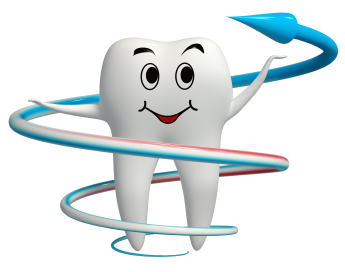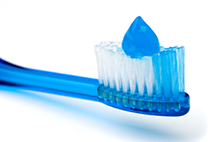The next time a patient innocently asks me, “What’s the best toothpaste to use?” I’m going to unleash a whole Chunky Soup can of “You Want The Truth? You CAN’T HANDLE THE TRUTH!!!” Gosh, that’s such an overused movie quote. Sorry about that, but still.
If you’re a dental professional, isn’t this the most annoying question you get, day after day? Do you even care which toothpaste your patients use?
No. You don’t. Asking a dentist what toothpaste to use is like asking your physician which bar of soap or body scrub you should use to clean your skin. Your dentist and dental hygienist have never seen a tube of toothpaste that singlehandedly improves the health of all patients in their practice, and the reason is simple:
Toothpaste is a cosmetic.
We brush our teeth so that out mouths no longer taste like… mouth. Mouth tastes gross, right? It tastes like putrefied skin. It tastes like tongue cheese. It tastes like Cream of Barf.
On the other hand, toothpaste has been exquisitely designed to bring you a brisk rush of York Peppermint Patty, or Triple Cinnamon Heaven, or whatever flavor that drives those tubes off of the shelves in the confusing dental aisle of your local supermarket or drugstore.
Toothpaste definitely tastes better than Cream of Barf. And that’s why you use it. Not because it’s good for you. You use toothpaste because it tastes good, and because it makes you accept your mouth as part of your face again.
From a marketing perspective, all of the other things that are in your toothpaste are in there to give it additional perceived value. So let’s deconstruct these ingredients, shall we?
1. Fluoride.
This was probably the first additive to toothpaste that brought it under the jurisdiction of the Food & Drug Administration and made toothpaste part drug, part cosmetic. Over time, a fluoride toothpaste can improve the strength of teeth, but the fluoride itself does nothing to make teeth cleaner. Some people are scared of fluoride so they don’t use it. Their choice. Professionally speaking, I know that the benefits of a fluoride additive far outweigh the risks.
2. Foam.
Sodium Lauryl Sulfate is soap. Soap has a creamy, thick texture that American tongues especially like and equate to the feeling of cleanliness. There’s not enough surfactant, though, in toothpaste foam to break up the goo that grows on your teeth. If these bubbles scrubbed, you’d better believe that they would also scrub your delicate gum tissues into a bloody pulp.
3. Abrasive particles.
Most toothpastes use hydrated silica as the grit that polishes teeth. You’re probably most familiar with it as the clear beady stuff in the “Do Not Eat” packets. Depending on the size and shape of the particles, silica is the whitening ingredient in most whitening toothpastes. But whitening toothpaste cannot get your teeth any whiter than a professional dental polishing, because it only cleans the surface. Two weeks to a whiter smile? How about 30 minutes with your hygienist? It’s much more efficient and less harsh.
4. Desensitizers.
Teeth that are sensitive to hot, cold, sweets, or a combination can benefit from the addition of potassium nitrate or stannous fluoride to a toothpaste. This is more of a palliative treatment, when the pain is the problem. Good old Time will usually make teeth feel better, too, unless the pain is coming from a cavity. Yeah, I’m talking to you, the person who is trying to heal the hole in their tooth with Sensodyne.
5. Tartar control.
It burns! It burns! If your toothpaste has a particular biting flavor, it might contain tetrasodium pyrophosphate, an ingredient that is supposed to keep calcium phosphate salts (tartar, or calculus) from fossilizing on the back of your lower front teeth. A little tartar on your teeth doesn’t harm you unless it gets really thick and you can no longer keep it clean. One problem with tartar control toothpastes is that in order for the active ingredient to work, it has to be dissolved in a stronger detergent than usual, which can affect people that are sensitive to a high pH.
6. Triclosan.
This antimicrobial is supposed to reduce infections between the gum and tooth. However, if you just keep the germs off of your teeth in the first place it’s pretty much a waste of an extra ingredient. Its safety has been questioned but, like fluoride, the bulk of the scientific research easily demonstrates that the addition of triclosan in toothpaste does much more good than harm.
Why toothpaste can be bad for you.
Let’s just say it’s not the toothpaste’s fault. It’s yours. The toothpaste is just the co-dependent enabler. You’re the one with the problem.
Remember, toothpaste is a cosmetic, first and foremost. It doesn’t clean your teeth by itself. Just in case you think I’m making this up I’ve included clinical studies in the references at the end of this article that show how ineffective toothpaste really is.
• You’re using too much.
Don’t be so suggestible! Toothpaste ads show you how to use up the tube more quickly. Just use 1/3 as much, the size of a pea. It will still taste good, I promise! And too much foam can make you lose track of where your teeth actually are located.
• You’re not taking enough time.
At least two minutes. Any less and you’re missing spots. Just ’cause it tastes better doesn’t mean you did a good job.
• You’re not paying attention.
I’ve seen people brush the same four spots for two minutes and miss the other 60% of their mouth. The toothbrush needs to touch every crevice of every tooth, not just where it lands when you go into autopilot and start thinking about what you’re going to wear that day. It’s the toothbrush friction that cleans your teeth, not the cleaning product. Plaque is a growth, like the pink or grey mildew that grows around the edges of your shower. You’ve gotta rub it off to get it off. No tooth cleaning liquid, paste, creme, gel, or powder is going to make as much of a difference as your attention to detail will.
The toothbrush needs to touch every crevice of every tooth, not just where it lands when you go into autopilot and start thinking about what you’re going to wear that day. It’s the toothbrush friction that cleans your teeth, not the cleaning product. Plaque is a growth, like the pink or grey mildew that grows around the edges of your shower. You’ve gotta rub it off to get it off. No tooth cleaning liquid, paste, creme, gel, or powder is going to make as much of a difference as your attention to detail will.
The solution.
Use what you like. It’s that simple. If it tastes good and feels clean to you, you’ll use it more often, brush longer, feel better, be healthier.
You can use baking soda, or coconut oil, or your favorite toothpaste, or even just plain water. The key is to have a good technique and to brush often. A music video makes this demonstration a little more fun than your usual lecture at the dental office, although, in my opinion you really still need to feel what it is like to MASH THE BRISTLES OF A SOFT TOOTHBRUSH INTO YOUR GUMS:
A little more serious video from my pal Dr. Mark Burhenne where he demonstrates how to be careful with your toothbrush bristles:
Final word.
♬ It’s all about that Bass, ’bout that Bass, no bubbles. ♬ Heh, dentistry in-joke there.
Seriously, though, the bottom line is that your paste will mask brushing technique issues, so don’t put so much faith in the power of toothpaste.
Also you may have heard that some toothpastes contain decorative plastic that can get swallowed. Yeah, that was a DentalBuzz report I wrote that went viral earlier this year. And while I can’t claim total victory on that front, at least the company in question has promised that the plastic will no longer be added to their toothpaste lines very soon due to the overwhelming amount of letters, emails, and phone calls that they received as a result of people reading that article and making a difference.
But now I’m tired of talking about toothpaste.
Next topic?
I’m bringing pyorrhea back.
 Trish Walraven RDH, BSDH is a mom and practicing dental hygienist in the suburbs of Dallas, Texas. She brushes her teeth every morning and night with a major-label toothpaste because she likes the way it makes her mouth taste but at lunch you never know. Sometimes it will be with a dry toothbrush, or dipped in her leftover coffee, one time she even brushed with a starlight peppermint out of desperation.
Trish Walraven RDH, BSDH is a mom and practicing dental hygienist in the suburbs of Dallas, Texas. She brushes her teeth every morning and night with a major-label toothpaste because she likes the way it makes her mouth taste but at lunch you never know. Sometimes it will be with a dry toothbrush, or dipped in her leftover coffee, one time she even brushed with a starlight peppermint out of desperation.
Resources:
PubMed.Gov: Role of dentifrice in plaque removal: a clinical trial.
PubMed.Gov: Clinical studies to determine the effectiveness of a whitening toothpaste at reducing stain
PubMed.Gov: Factors contributing to adverse soft tissue reactions due to the use of tartar control toothpastes.
Vicky Flint RDH: The Truth about Toothpaste
DearDoctor.com: Toothpaste-What’s in it?
Trisha O’Hehir RDH: Dry Brushing -The Toothpaste Secret
Please share this article if you enjoyed it!



